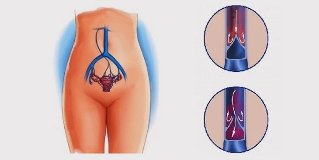In this article you will learn: why the varicose veins of the pelvis is considered to be a disease, and not a variation of the varicose veins feet; who has this disease can occur and why. The manifestations and the diagnosis of this pathology, how to treat it properly, the chances of recovery.

Varicose veins, pelvic is the weakening of the internal walls or external venous of vessels of the pelvic region, leading to over-expand its diameter. Varicose changed from vienna are not able to provide the output of blood from the pelvis, which leads to stagnation and the total destruction of the vascular wall. As a result of the breaking of the structure and functions of the female genital system.
The initial phase of the disease cause only minor discomfort in the area of the external genitalia and, in the lower part of the belly. Women who are at forms of pelvic varicose veins suffer from constant pain, various gynecological diseases, unproductive, have cosmetic defect in the form of complicated extended venous node in the groin, labia or at the entrance of my vagina.
The disease can be completely cured, but to avoid relapse is to have a lifetime of prevention. Deal with this problem together with the vascular surgeons obstetrician-gynecologists.
Varicose veins in the pelvic in men as in women not the case. But the similar disease is the varicocele. Mechanisms of occurrence and manifestations similar with the so when pelvic varicose veins. Varicose veins occur in the left testicle and in the course of seed power cable due to the fact that, on the left side vienna, the egg stagnant, blood. She back played from the left renal vein, which empties into vienna.
The essence of the pathology, as is serious
Outer and inner genital tract as well krovosnabjaemah. To provide an adequate output of blood you need a strong network of vessels venous. Therefore, the venous system of the pelvis in women is well developed. Each vienna has a strong wall, equipped with valves, monitored closely the veins. All of this forms a set with the execution of the venous network of the pelvic region which collects blood from the crotch to the open air the reproductive organs (vulva, vagina), special structures (ovaries, uterus), and it down to the bottom Polow vienna.
Varicose changed veins of the pelvis differ from healthy fact that they are:
- Expanded in diameter;
- Overflowing blood;
- Redundant complicated;
- Have protrusions such as we;
- Soft and weak.
Pelvic of vienna, the affected varicose veins, can collect the blood of the genitals and other organs, but usually are not able to carry it on more large vessels (vena cava). This causes the stagnant blood in the pelvis, and penetrating through the wall of the vein, attack the tissues, which must no. They become swollen, sore and lose their function.
But the varices of the pelvic floor dangerous:
- Various disorders of the ovary;
- Uterine bleeding and different disorders;
- Infertility, the threat of an interruption of the pregnancy and the inability of natural childbirth;
- The formation of a blood clot in the lumen varicose changed veins, which threatens your safety margin, from a place of education and migration to the heart and blood vessels of the lungs. It is the most dangerous thing complication, threatening the life – pulmonary embolism (with pe).
Causes
Mainly the varicose veins pelvic happens with the sexually mature women:
- The 20 years – 20%;
- 20 to 30 years – 30%
- 30 – 45 years – 50%
Mechanisms of varicose veins of the renaissance, the venous system of the pelvis:

- (80%). They are the larger trunk veins which collect the blood from the uterus and ovaries and are you directly at the hollow (right) or kidney (left) of vienna. When the break occurs, is completely blocks the venous output.
- Even the weakening or destruction of the venous wall the veins pelvic – all of them simultaneously expand and are not able to slow down, to boost the blood that overlaps departments.
- Reverse the flow of blood from a vein of the thigh in the surface sexual vienna, which collects the blood from the groin and the genitals, preventing the output. As a result, the pressure on her increases, and his trunk and all tributaries of the varicose expand.
The immediate causes run these mechanisms may be:
- Innate weakness or dysplasia (underdevelopment) of the venous wall and valves.
- Hormonal adjustment in the female body (puberty, pregnancy, menopause, ovarian diseases).
- Frequent inflammatory processes, endometriosis, operation, adhesive process, to the detriment of the content.
- Transferred thrombosis and thrombophlebitis of the veins the pelvic.
- The hard physical work.
- Extended stay in a lying or sitting position.
- The excess of weight.
- The pregnancy and childbirth.
- Regular interruption of the sexual act over the years, especially in the absence of orgasm.
- The curvatures of the uterus at a later time or forward.
- Tumors pelvic.
- Tilting of the uterus.
The degree of varicose veins – rating
For the anatomical reason (prevalence) varicose veins pelvic divided into three types:
- Venous plethora in the pelvis;
- Perineal varicose veins and other;
- Combined form.
To reflect the character of pathological changes of the disease is divided into three degrees:
- First – the vessels of any one of the body plexus the pelvis does not exceed the diameter of 0.5 cm, redundant, complicated.
- Second – the diameter of the vein increased by 1 cm, common process, not only in the plexus of organs(uterine, ovarian), but about one of them (okolomatocnah pulp).
- The third extension (ectasia) more than 1 cm, affecting all the vessels – intraorganic, about bodies, and trunk (the trunk of ovarian vienna).
The greater the degree of the disease, the worse magnified vienna and heavier than the stagnation of blood within the pelvis.
The characteristic symptoms of
Women with varicose veins pelvic point:
- Persistent or recurrent abdominal pain, increasing at night or after loads mainly during the second half of the cycle (next month). When 3 grade, the pain can be very strong.
- Itching, burning, swelling and cyanosis of the genital organs.
- Painful periods and sexual intercourse.
- Abundant menstruation and the fallopian irregular bleeding cycle.
- The inability to get pregnant.
- Thick complicated of vienna, in the perineal region and lips.
- Frequent, painful urination.
- The express manifestation of pre-menstrual syndrome.

Diagnosis
To confirm the diagnosis pass:
- Ultra-sound through the stomach and through the vagina (transvaginal) with the use of special sensors – Doppler, and full-duplex treatment of the veins of the pelvis. The simplest and most informative method.
- Endovascular phlebography – the introduction of special drugs in ovarian vienna.
- The ct scan with contrast.
- Diagnostic laparoscopy.
Methods of treatment
Varicose veins in the pelvic along with dealing with the vascular surgeons or obstetrician-gynecologists. According to the modern concepts of treatment consists of the areas:
- The normalization of the life style;
- Conservative medical treatment;
- Compression and the other therapy;
- The surgical treatment.
Heal varicose veins pelvic possible. To this, the professionals make up the individual plan of treatment, patients, women need to life stick therapeutic recommendations.
1. The normalization of the life style
Because the wrong image of life is a pre-requirement, and the immediate cause of the expansion of the expansion of the veins the pelvic, their standardization help to heal:
- Delete the long stay in position standing or sitting (more than 2-3 hours, without an interval).
- Do not lift weights and to stop strenuous physical work.
- During the day make download fitness for the pelvic (exercises birch, bike or just relax 10-15 minutes, with high above the level of the body of the pelvis.
- Reduce the weight (obesity).
- Do not take a hot bath, and replace it with a shower of sensations.
- Avoid alcohol and smoking.
2. Medical therapy
The treatment of varicose veins of the extension to pelvic veins of any mode is not possible without medical support. When the first level is the main therapeutic event, with the second and third complements the full treatment.
Are used as medicines:
- Special drugs – strengthen the vessels venous.
- Anticoagulants – liquefy the blood, facilitate their promotion in the blood.
- Drugs that improve the microcirculation.
For more of a group of medications prescribed depending on the availability of deviations in the organism:
- Medications female hormones (when dishormonal violations).
- Analgesics and anti-inflammatory.
- Medicines to stop blood styptic medicines for the treatment of uterine bleeding.
3. Compression therapy
One of the effective means in the treatment of varicose veins in the vulvar region and perineum is the compression of impact. The principle of this method is similar to the use of elastin bandages when varicose veins of the legs. Compression (compression) of the surface of the veins from the outside contributes to the emptying of blood. To create this type of effect able to stockings or special compression shorts of the treatment of knitted fabrics. They can be purchased in pharmacies and specialized shops, beauty salons health products, individually, by choosing the size and strength of compression.
Sclerotherapy – peg leg extended of vienna, with the introduction in the lumen special medications, which make their accession. This treatment is carried out in the exterior (subcutaneous tissue) pelvic varicose veins without hospitalization in the hospital. Internal of vienna can also be treated, but this procedure is technically more complex and passes in operating conditions.
4. Surgical treatment
Varicose veins pelvic better than cure operating by means of:
- 2-3 degree of the disease;
- Rapid progression of the disease;
- The planning of the pregnancy;
- As the pain syndrome;
- Permanent tubal hemorrhage and other pathologies gynecologic.
The main types of operations when pelvic varicose veins:
- Deviation – special operation through a puncture abdominal. Running wear, crossing or removing the ovarian vienna. Therefore, solving the inverse problem the reflux of blood for her.
- Removal of varicose veins through small punctures or cuts in the skin are removed, altered subcutaneous vienna, tied outdoor sex vienna on the site of the confluence thighs vessels.
- Gynaecological intervention – the removal of tumors, the elimination of the curvatures of the uterus.

Forecast
If not treated varicose advanced veins of the pelvis, with the time, even more if you expand (95%), the threat of dangerous complications. The other 5% of women with subcutaneous varicose veins groin 1-2 degree, which arose after the birth, the pathology is not reinforced, but it will never pass by itself.
If you treat the disease, you can achieve a full recovery (10% to 50% depending on the degree) or a significant improvement of the state (45-50%), especially in the case of the combination of surgical techniques conservative. But, in any case, after the integrated treatment has had a lifetime prevention, which consists in the observance of the recommendations of style of life, as periodic medical or compression support, the weakening of the veins.




































